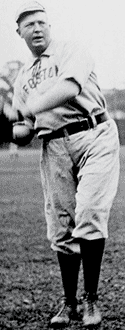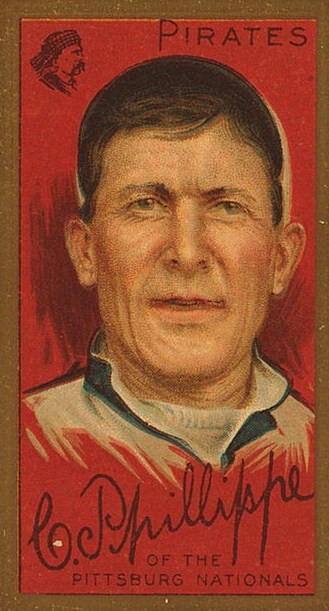Golden Moments in Sports History
Birth of the American League and the First World Series
The first Super Bowl in 1967 came about after the National Football League and the upstart American Football League agreed to quit competing for players and merge into one league. That story followed a script similar to what happened in baseball at the beginning of the century as the new American League and the established National League made peace, setting the stage for the first Fall Classic.
Like all creations, the American League began with an idea.
The original eight teams of the American League (in order of finish in 1900) were as follows, where the city in parentheses was the home of the franchise in 1900.
The league signed players away from the National League which not only refused to recognize the AL as a major league but considered it an arch-enemy. Johnson knew that NL players wanted higher salaries, injury pay, and a less restrictive reserve rule. Among the NL defections were: Nap Lajoie, Cy Young, Sam Crawford, Willie Keeler, and Ed Delahanty. In 1901, the Junior Circuit attracted as many fans as its older rival.
By 1903, the National League was ready to bury the hatchet. A National Agreement was negotiated that (a) created a three-man commission to oversee baseball (no Commissioner until 1920), (b) recognized only the National and American Leagues as major leagues with all others classified as minor leagues, and (c) required all major league teams to honor all player contracts (i.e., no poaching other teams' players).
The American League's 1903 lineup of teams in order of finish: Boston Americans, Philadelphia Athletics, Cleveland Blues, New York Highlanders, Detroit Tigers, St. Louis Browns, Chicago White Sox, and Washington Senators. Nicknames changed, but the eight franchises remained the same until the Browns moved to Baltimore in 1954.
National League 1903 order of finish: Pittsburgh Pirates, New York Giants, Chicago Cubs, Cincinnati Reds, Brooklyn Superbas, Boston Nationals, Philadelphia Phillies, St. Louis Cardinals. These eight franchises made up the Senior Circuit until the Dodgers and Giants moved to the West Coast in 1958.
The National Agreement did not mandate a World Series. However, as September began, Boston was running away with the AL crown (they eventually won by 14 1/2 games) and the Pirates seemed likely to take their third straight pennant (by 6 1/2 games as it turned out). The owners, Henry Killilea of Boston and Barney Dreyfuss of Pittsburgh, agreed their clubs should meet in a best-of-nine series for the "World Championship." Player-managers (and future Hall-of-Famers) led both teams: Fred Clarke of Pittsburgh and Jimmy Collins of Boston.

Boston in
front, Pittsburgh in last row
Game 1 – October 1 at Huntington Avenue Baseball Grounds, Boston: Pittsburgh's ace, Deacon Phillippe (25-9), outdueled Cy Young (28-9) of Boston 7-3. The Pirates belted 12 hits, including a homer by Jimmy Sebring, and Boston contributed four errors.
Game 2 – October 2 at Boston: Bill Dinneen (21-13) gave only three hits as Boston evened the series 3-0. Lefty Sam Leever (25-7), hampered by arm trouble late in the season, lasted only one inning. Patsy Dougherty, with only 4 home runs all season, hit two. These were the last round-trippers in the Series. (Leever's disability was a major reason for the Pirates' Series loss.)
Game 3 – October 3 at Boston: Plagued by injuries on his staff, Clarke went with the Deacon on one day's rest. He pitched even better than in Game 1, holding the Americans to four hits in a 4-2 triumph. Cy Young relieved in the third inning and allowed only one run the rest of the way, but the damage had been done.
Game 4 – October 6 at Exposition Park, Pittsburgh: After a travel day and a rainout, Phillippe started again and continued his domination. Leading by four in the ninth, the Pirates withstood a Boston rally to win 5-4. Dinneen was the complete game loser. Leading 3-1 in games, Pittsburgh needed only two wins in the remaining five games to capture the first World Championship.
Game 5 – October 7 at Pittsburgh: Needing a big game from their ace, Cy Young, the Americans got it in an 11-2 rout.
Game 6 – October 8 at Pittsburgh: Boston tied the series with a 6-3 win behind Bill Dinneen, who pitched with one day's rest. Leever took the loss.
Game 7 – October 10 at Pittsburgh: Young turned the tables from Game 1, outdueling Phillippe 7-3 to propel Boston to a 4-3 Series lead.
Game 8 – October 13 at Boston: Facing elimination, Clarke threw Phillippe after two days off. Collins countered with Bill Dinneen. Deacon pitched well, allowed only 8 hits and 3 runs. But Dinneen was impeccable – a 4-hit shutout. Boston won the first World Series 5 games to 3.
Follow-up: 1904
Unfortunately for baseball fans, John McGraw's New York Giants won the NL pennant in 1904. Both McGraw and his owner, John Brush, hated Ban Johnson. While owner of the Reds in the early 1890s, Brush developed a dislike for Johnson and even took away his press pass. McGraw had drawn Johnson's wrath in 1901 as manager of the AL's Baltimore Orioles. Ban fined McGraw repeatedly for his bullying, cheating, and intimidating umpires. The next season found McGraw back in the NL with the Giants. He regularly referred to the AL as a minor league and contemptuously refused to play Boston, repeat AL winners, after the 1904 season. "Never while I am manager of the New York Club and while this club holds the pennant will I consent to enter into a haphazard box-office game with Ban Johnson." 10,000 Giant fans signed a petition asking McGraw to reconsider to no avail.
Brush was more amenable to a World Series because of the additional profit it would bring. So he lobbied successfully to change the rules to require the two pennant winners to meet in the post-season. So when the Giants repeated in 1905, they beat the Philadelphia A's 4-1 behind Christy Mathewson's three shutouts.
1904 was the only season after its inauguration that the World Series was not played until 1994, when the players' strike cancelled the season prematurely.
Interesting facts about the 1903 Series
- The Pirates' star, shortstop Honus Wagner, had a disappointing series. He hit only .222 with 3 RBI. He also committed several crucial errors.
- The largest crowd in the Series was 17,038 in Pittsburgh for Game 7 (on a Saturday). Game 8 surprisingly had the smallest crowd, 7,455 in Boston on a Tuesday.
- The teams combined for 32 errors, an average of 4 per game. Game 7 was the sloppiest with 7 errors. Players used small, flimsy gloves in 1903.

Ban Johnson

Fred Clarke

Jimmy Collins

Cy Yound

Deacon Phillippe

Bill Dinneen
Honus Wagner
